Key points for citrus tree management in March

|
March is the flowering season for citrus fruits such as mandarin oranges and tangerines. During this period, the germination of flower buds and the growth of new shoots require a huge amount of nutrients. Inadequate nutrient supply may result in poor flower development, weak, ineffective or deformed flowers that cannot be pollinated and set fruit normally, negatively affecting yields throughout the year. Let’s take a brief look at the key points of citrus management in March. 1. Fertilization strategy 1. Fertilizing young trees For young trees, it is recommended to adopt a "small amount and multiple times" fertilization method, applying water-soluble fertilizer (such as 1% decomposed cake fertilizer water plus 0.2-0.3% compound fertilizer , etc.) about every 7 to 10 days, mainly with quickly absorbed nitrogen fertilizer, supplemented with phosphorus and potassium fertilizers to promote root development and new shoot growth. 2. Fertilization of fruit trees For fruit-bearing trees, fertilization should be adjusted according to the tree's vigor: no fertilizer for vigorously growing trees, less fertilizer for strong trees, and more fertilizer for weak trees. Before germination, apply mainly quick-acting nitrogen fertilizer, with appropriate amounts of phosphorus and potassium fertilizers. Supplement nutrients through foliar spraying 1-2 times, such as 0.2-0.3% potassium dihydrogen phosphate and boron fertilizer, to enhance tree vigor and improve flower quality. 2. Pruning points 1. Pruning young trees The goal of pruning young trees is to develop a good tree shape and expand the crown. Light pruning should be the main method, with timely bud removal and shoot thinning to remove buds and shoots with poor growth angles, as well as all flower buds, in order to reduce nutrient consumption and accelerate the expansion of the crown. 2. Pruning of initial fruiting trees The goal of pruning early-bearing trees is to continue to develop the crown and balance tree vigor. Adopt a pruning method of heavy top and light bottom, heavy outside and light inside to promote the growth of new branches. You can appropriately thin out the overly long spring shoots and flower buds in the middle and upper parts of the crown, and retain the fruiting branches in the lower part of the crown. 3. Pruning of fruit trees Pruning is carried out according to the principles of "ventilation, light transmission and reasonable load" to balance the tree vigor and promote stable and high-quality yields. For trees with few flowers but vigorous spring shoot growth, appropriately thin out some upright, strong, and dense branch groups; for trees with weak tree vigor and many flowers, thin out some leafless flower branches, thin flower branches, dense flower branches, and clustered buds on the spring shoots. 3. Pest and disease control Focus on preventing and controlling diseases and pests such as anthracnose, scab, sand bark, canker, citrus psyllids, red spiders, and thrips. The above is an introduction to the key points of citrus management in March. Please note that due to differences in climate conditions, temperature, tree vigor, tree age and variety in orchards in different regions, it is recommended that fruit farmers adjust and implement management measures according to the specific conditions of their own orchards.
|
<<: How to fertilize Kalanchoe with potassium dihydrogen phosphate, fertilization tips
>>: How to repot the Kalanchoe? What to do if it wilts after repotting?
Recommend
The Flower Language and Cultural Legends of Winter Jasmine
The Flower Language of Winter Jasmine Forsythia i...
When is the best time to transplant green onions?
Scallions are an indispensable vegetable and cond...
What is the difference between hot polygonum and red polygonum
1. Leaf Difference The leaves of Polygonum hydrop...
Diseases and prevention methods of Schefflera arborvitae
Schefflera leaf spot symptom In the early stage o...
What to do if pearl bush has root rot
Causes of root rot in pearl bush Overwatering Pea...
What to do if Clivia leaves turn yellow
1. Astigmatism Reason: Clivia is a semi-shade pla...
Melon planting methods and management techniques
Melon is deeply loved by consumers for its unique...
It is best to water peanuts every few days
How often should peanuts be watered? Water the pe...
How to propagate passion fruit and what to pay attention to
Passion fruit reproduction method There are two m...
Is it good to keep jasmine at home?
1. Is Feng Shui good? It is very good feng shui t...
The main value of Coreopsis grandiflora
The main value of Coreopsis grandiflora: ornament...
How to distinguish small-leaf gardenia from large-leaf gardenia
The difference between small-leaf gardenia and la...
Geranium cultivation methods and precautions
1. Soil Preparation When growing geraniums at hom...
Can I use ordinary soil for my green radish?
1. Yes The vitality of the green ivy is very stro...
How to treat black spot disease of rose
Understanding Black Spot pathogen It belongs to t...









